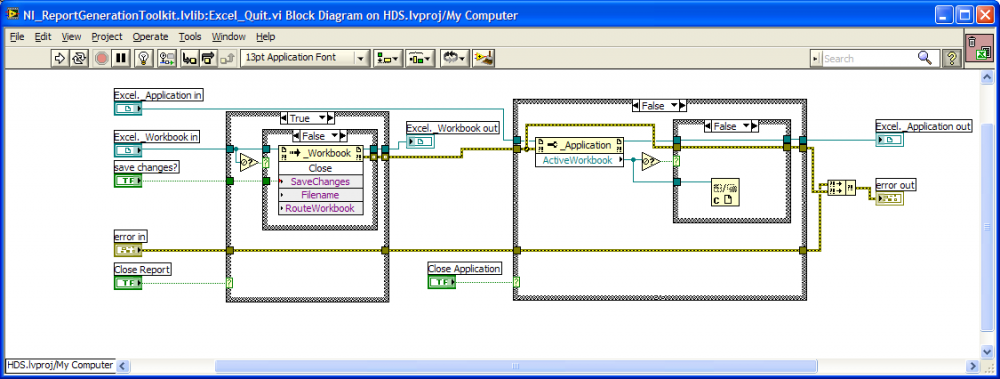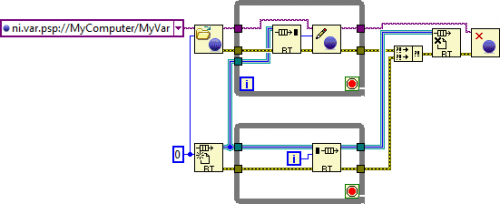-
Posts
470 -
Joined
-
Last visited
-
Days Won
20
Content Type
Profiles
Forums
Downloads
Gallery
Everything posted by viSci
-
Yes, I have the OpenG ZLIB vi's and have a put together a way to extract a single file to disk and then read it. It appears that there are vi's that look like they can setup a zlib file pointer but I cannot see how to read out the data from the internal pointer. Any hints? Ok, I must have an old version, I just looked at 2.5.1 and I do see the streaming vi's. Thanks!
-
I was wondering if it is possible to open up a ZIP archive and read the contents (text file in my case) without creating a temp copy on the file system. Thanks
-
.thumb.jpg.5d2ee2fea691c9fe3fab4270ba8e531d.jpg)
Best Method for Reconnectable Host Communication?
viSci replied to Jordan Kuehn's topic in Real-Time
I use NSV's all the time and they are reliable when used correctly. If RT hosted NSV's drop off the network then you will receive definite error messages to that effect on any static or dynamic NSV R/W node. Once the RT controller comes back on line NSV's automatically reconnect and become viable. Also any HMI controls or indicators can be easily set to blink or display a red PSP status if the binding NSV goes offline. -
Ok, but I do not understand how to stream to the raid disk without having to go through the processor. I presume that you still have to use the IMAQ driver and do a grap on the camera and then do something with the imaq image. It seems that NI only supports triggered image capture not video.
-
Hi All, I would like to capture video (30Hz, 24bit color, 640x480) in sync with some DAQmx channels. The data needs to be streamed to disk and retrieved back to display in realtime with data. My question is what hardware is recommended to support the video portion of the system. I am planning on a cameralink interface that has hardware triggering but am not sure if I will need any special RAID hardware for the streaming to disk. Also what is the most efficient format to use: IMAQ->AVI->Disk IMAQ->JPEG->Disk IMAQ->(Some other GPU compression)->Disk IMAQ->Array->TDMS I am not really going to processes the video so would it be possible to use some 3rd party activex controls that are optimized for GPU video streaming?
-
Not sure how I stumbled on to this, but thought LAVA folks might find it interesting... http://www.slideshar...ormal&rel=15910
-
.thumb.jpg.5d2ee2fea691c9fe3fab4270ba8e531d.jpg)
Closing an excel sheet from LabView without saving
viSci replied to JurjenHendriks's topic in Database and File IO
-
Tell us what you want to do with the DSC, maybe we can help.
-
IR thermocouples can have response times ~10ms, check out Omega.com
-
Sounds alot like NI's own PSP (Publish Subscribe Protocol). The only problem is that NI does not fully give us the ability to create subscriptions that can be used to create user events. We can of course use the DSC toolkit, but IMHO it should be built into the NSV API and available also in RT since it affords such a powerful architecture.
-
You can also use the GXML libraries. http://zone.ni.com/devzone/cda/epd/p/id/6330 But as jgcode mentioned, you should benchmark first because they can really hit your cpu pretty hard.
-
For small videos you can convert to GIF and use a cheap activex control like AniGIF http://www.jcomsoft.com/anigif.htm
-
.thumb.jpg.5d2ee2fea691c9fe3fab4270ba8e531d.jpg)
labview queue from native windows dll
viSci replied to Mark Zvilius's topic in Calling External Code
Could you also show us the code for the ICubeSDK_SetCallback function? I am excited about using this same idea to create a LV user event from a NSV value change callback registered within a CVI dll -
Yes, I had thought about using the FileVersionInfo.vi but it appears that this information does exist in the cRIO (VxWorks) file system. Actually, I wonder why NI does not build this into all exe's with a native property node to read it out. Also you can use property nodes to make sure the EXEs and the Installers have the same version numbers Could you tell me what property nodes you are referring to?
-
I would like to settle on a consistent version management method that will give me basic version numbering on the software components in my system. I have 3 types of HMI (windows) and 2 flavors of cRIO code. I would like to have one global software version embedded in each exe so that it can be locally and remotely verified. The problem I have is how to reconcile all the different version numbers that exist such as the SVN revision, the LV build revision, LV VI revisions and now an additional project based version vi that I am starting to include for all builds. I was hoping to hear from others who have navigated these waters before and might have some tips to offer.
-
Although not what I was looking for initially, one thing I discovered that is pretty cool is that you can feed DSC NSV value change events (they propagate up to LV as User Events) to a Event Callback node (normally used for activex events) and you can then wire in a static node for any callback vi that will automagically execute when a NSV changes value. The holy grail would be to generate User Events from NSV changes without the DSC. Now that I know it can be done in CVI it should be possible to create this in LV. I am not trying to get out of paying for the DSC (we already have a license) it is just that I believe, as LAVA citizens, we have the unalienable right to be able to access the entire shared variable API with just LV.
-
You could use the new LabVIEW C code generator http://zone.ni.com/devzone/cda/tut/p/id/11784 Or you could build your vi's into dll's and call from CVI
-
For some reason this mechanism is forbidden in LV but seems to be supported in CVI. It appears that you can do an async read on a NSV and specify a callback function which gets invoked when the NSV value changes. Does anyone know if it is possible to wrap this functionality up in a dll that would allow me to specify a NSV by URL and a callback vi to execute.
-
.thumb.jpg.5d2ee2fea691c9fe3fab4270ba8e531d.jpg)
Replacement for the old Callee's Property
viSci replied to viSci's topic in Application Design & Architecture
AWESOME!!! Thanks a Million. -
I have some legacy code that used the Callee's Property to discover the names of subvi's within a vi that is within a running exe. The code uses a static reference to the vi and attempts to extract all the callee names. Of course this no longer works in LV 2010 but was wondering what kind of workarounds people have discovered. I can understand protecting an exe from the outside but it seems there should be someway to enable this functionality in your own created code.
-
You might take a look at a pipelining architecture... http://zone.ni.com/reference/en-XX/help/371599F-01/lvfpgaconcepts/fpga_pipelining/
-
.thumb.jpg.5d2ee2fea691c9fe3fab4270ba8e531d.jpg)
Unable to create XControl properties in LV2010
viSci replied to Jeffrey Habets's topic in User Interface
I posted about something similar here... http://forums.ni.com/t5/LabVIEW/Add-XControl-Properties-in-LV2010-is-not-working-correctly/m-p/1244688#M525523 -
Here are some links that I found useful. http://zone.ni.com/devzone/cda/tut/p/id/9861 http://www.controlguru.com/2007/011107.html
-
FYI - Here is a Question and Answer to Jason Reding at NI concerning the use of RT-FIFO enabled NSV's: 6. Are there any caveats in creating programmatic access or alias binding to cRIO hosted NSV's with RT-FIFO enabled? The automatic deployment of RT-FIFOs to decouple your read/write access from the jitter occurred when accessing the network stack is only a feature of the static variable node. When using the programmatic API, you will be communicating with the variable in the same manner as if the variable had been deployed without the RT-FIFO option enabled. If this is functionality you need, we recommend you use the programmatic RT-FIFO API directly to decouple your deterministic loop from your network communication loop. This loop would look something like the following: In terms of binding, my understanding is that the binding just serves as another level of indirection to the original point deployed in the SVE. In essence, the SVE of the bound point becomes a client of the SVE of the original point. However, the configurations applied to the deployed points in the two SVE's are still unique. In other words, just because the original point was configured with the RT-FIFO option enabled doesn't mean clients accessing the bound point will access the bound point through an RT-FIFO. For this to occur, the configuration for the bound point would also need to enable the option for the RT-FIFO. The same goes for the network buffer configuration options. Accessing bound points using the programmatic interface has no additional caveats over accessing a non-bound point through the programmatic API.




